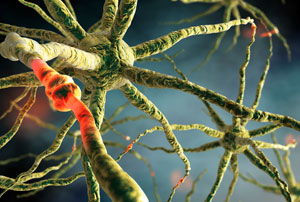 Tuesday 13 July 2010 2:47pm
Tuesday 13 July 2010 2:47pm A previously hidden mechanism regulating how brain cells communicate has been discovered by a University of Otago scientist in collaboration with colleagues at the University of Aberdeen. The researchers believe targeting the mechanism may lead to new therapies for the symptoms of motor neurone disease.
A previously hidden mechanism regulating how brain cells communicate has been discovered by a University of Otago scientist in collaboration with colleagues at the University of Aberdeen. The researchers believe targeting the mechanism may lead to new therapies for the symptoms of motor neurone disease.
Otago neurobiologist Associate Professor Ian McLennan and his Aberdeen colleagues have discovered that a protein known as transforming growth factor beta 2 (TGF-β2) appears to regulate how motor neurons send signals to neighbouring brain cells.
Their findings are newly published in the prestigious US journal Proceedings of the National Academy of Sciences (PNAS).
Associate Professor McLennan says the discovery of the TGF-β2protein's previously invisible role in regulating brain cell communication surprised the team.
“We did not predict this, and the finding fundamentally alters our understanding of how communication between cells in the brain's motor system is controlled. It is also likely that this mechanism plays a role in other brain signalling systems.”
Historically it was thought that the information flow from cell to cell was controlled by the number of quanta, or packets, of neurotransmitter chemicals released at any one time across specialised cell junctions known as synapses, he says.
“Now we have found good evidence that the TGF-β2 protein regulates the size of the packets released and thus the amount of neurotransmitter they contain. This gives the protein a key role in allowing synaptic signalling to successfully occur.”
Associate Professor McLennan says his interest in delving into how TGF-β2 acts in the brain stems from his earlier findings that administering the protein relieved symptoms of early-stage motor neurone disease in mice.
“Unfortunately, while it is harmless to mice, TGF-β2 is known from other studies to be highly toxic when administered to humans. Now that we are aware of how TGF-β2 works we will look for other ways to take advantage of this signalling system to pursue non-toxic therapies.”
Any resulting therapy would not be a cure for motor neurone disease, but may be able to alleviate symptoms during the early stages of the devastating condition, he says.
The study was supported by the Marsden Fund of New Zealand.
Associate Professor McLennan says the basic research supported by the Marsden Fund continues to open possibilities for his team's search for new drugs for degenerative conditions.
Publication details:
TGF-β2 alters the characteristics of the neuromuscular junction by regulating presynaptic quantal size
Sitt Wai Fong, Ian S. McLennan, Andrew McIntyre, Jayne Reid, Kathleen I. J. Shennan, Guy S. Bewick
www.pnas.org/cgi/doi/10.1073/pnas.1001695107
For more information, contact
Associate Professor Ian McLennan
Department of Anatomy & Structural Biology
University of Otago
Tel 64 3 479 7346
Email ian.mclennan@otago.ac.nz
Website: Anatomy and Structural Biology
A list of Otago experts available for media comment is available elsewhere on this website.
Electronic addresses (including email accounts, instant messaging services, or telephone accounts) published on this page are for the sole purpose of contact with the individuals concerned, in their capacity as officers, employees or students of the University of Otago, or their respective organisation. Publication of any such electronic address is not to be taken as consent to receive unsolicited commercial electronic messages by the address holder.